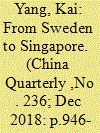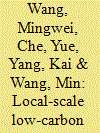|
|
|
Sort Order |
|
|
|
Items / Page
|
|
|
|
|
|
|
| Srl | Item |
| 1 |
ID:
192093


|
|
|
|
|
| Summary/Abstract |
Since the mid-2010s, China has experienced scores of cross-regional protests by claim-making groups, despite the Xi regime’s tightening societal control. In this article, I examine this form of contention and differentiate three types of groups that make claims for rulemaking, rule-enforcement, and political reform. Then, I compare state responses to each type by focusing on three specific groups: veterans, investors, and leftist students. Instead of crushing all attempts at cross-regional mobilization, the regime has at times made concessions. It has been slow to resort to outright repression, especially when protesters have merely demanded policy change or enforcement. Although this repertoire of contention appears in only some of China’s many protests, it is becoming more widespread and in some cases impacts government policy.
|
|
|
|
|
|
|
|
|
|
|
|
|
|
|
|
| 2 |
ID:
167063


|
|
|
|
|
| Summary/Abstract |
China can be described as a “learning state” which has adapted to changing conditions and frequently turned outward for lessons. In recent years, Sweden and Singapore have drawn particularly strong interest from Chinese academics because the two countries represent two different “third ways” between Communism and capitalism and have been useful for developing a socialism “with Chinese characteristics.” Sweden is seen to symbolize the ideals of social equity and harmony while Singapore is seen as a model of authoritarian state-capitalism. China's transformation has resembled the Southeast Asia city state's model more than the Scandinavian social democratic model. Since Xi Jinping assumed power in 2012, interest in Sweden has reached a nadir, while attentiveness to Singapore has peaked. Although Chinese state-capitalism faces many challenges, including rising inequality and persistent corruption, it will be difficult to find an alternative role model that can successfully combine one-party rule with economic modernization.
|
|
|
|
|
|
|
|
|
|
|
|
|
|
|
|
| 3 |
ID:
110373


|
|
|
|
|
| Publication |
2011.
|
| Summary/Abstract |
To achieve a goal of reducing the emission intensity of carbon dioxide in 2020 by 40-45% relative to 2005 in China, the framework for a low-carbon scenario was developed on a small scale in Minhang District, Shanghai. The STIRPAT model was employed to reveal the factors that contribute to CO2 emissions in this district: the increase of population, affluence and urbanisation level would increase CO2 emissions, but energy intensity would decrease. Stakeholder involvement was another key component of the framework, and in this case, several rounds of negotiation and feedback resulted in fifteen final scenarios with the estimations of CO2 emissions in 2015. For the low-carbon development plan of Minhang District, the model considered the actual capacity and development potential of this district, the best scenario combining with the high rates of affluence growing and energy intensity reducing as well as the middle rates of population growth and urbanisation level. The final CO2 emissions of this scenario were 66.1 Mt in 2015. Based on these results, strategic suggestions have been proposed to reduce future energy intensity in Minhang District through industrial and energy resource structure reformation, lifestyle change and the transportation system improvement in this district.
|
|
|
|
|
|
|
|
|
|
|
|
|
|
|
|
| 4 |
ID:
183925


|
|
|
|
|
| Summary/Abstract |
Existing studies have portrayed a lack of broad-based solidarity as a major hurdle to sustained social mobilization. Examining Chinese veterans, this article contends that intragroup fragmentation within a social group can actually help sustain activism when in contention with authorities. This is achieved through a mechanism of “selective identification”: when subgroups make demands, they identify with better-off counterparts, while distancing themselves from veterans who are more disadvantaged. Through this, each successful gain achieved by one subgroup generates and legitimizes claims by other subgroups. Thus, intragroup divisions have not disempowered claimants but have been used as leverage against the government when making demands. This mechanism poses a dilemma for the government: a unified policy response to veteran groups agitating for better conditions is not accepted by groups that believe they deserve more, whereas a differentiated policy creates grievances among those who receive less. Both types of grievances can help mobilize and sustain collective action, even though veterans’ activism has declined in recent years because of a more repressive overall environment.
|
|
|
|
|
|
|
|
|
|
|
|
|
|
|
|
|
|
|
|
|